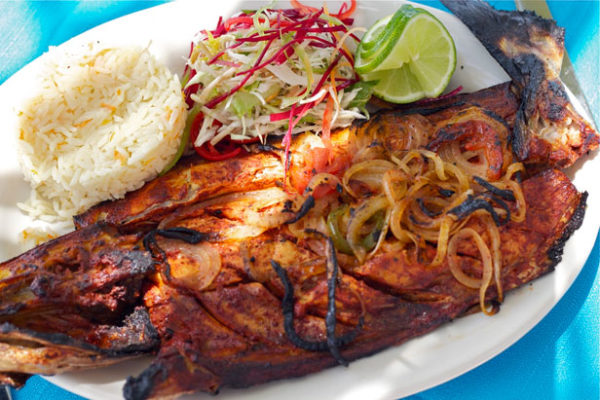The Mexican state of Quintana Roo features a coastline that stretches from Cancun to Belize. As a result, seafood heavily influences the traditional cuisine of the state and various dishes take advantage of the abundance of tropical produce available. Culinary influences from Mayan culture also make their appearence in local cuisine such as the iconic cochinita pibil, a marinated pork dish.
Tikin-Xic
The dish, also spelled “tik-n-chik,” combines fish with achiote paste, a staple of Quintana Roo cooking. The paste is made from the seeds of the annatto tree, combined with pepper, cumin, and cloves. The whole fish marinates for about three hours and is then placed on a banana leaf with onions, tomatoes and peppers, and coated with olive oil and beer. The dish then bakes for about 40 minutes, and is served with the banana leaf as a garnish.
Cochinita Pibil
In this Mayan-influenced dish, a marinade comprised of sour orange juice, garlic, cinnamon and achiote paste, a paste derived from achiote seeds, flavors pork meat. Cooks marinate the meat for up to a day before cooking. They then wrap the meat in a banana leaf about four feet long and cook the entire dish for about three hours.
Poc-Chuc
Pork steaks marinate in a mixture of sour orange juice, thyme and oregano. Achiote paste lends an earthy flavor and a yellow color to the dish.The pork steaks are then grilled, and often served with a side of pickled red onions and corn tortillas. In a variation of the dish, a spicy onion sauce is served with the pork instead of the pickled onions. Poc-Chuc is a Mayan dish that developed in the pre-Columbian era. Originally, the dish was made from roasted wild boar, however, pork became the primary ingredient when the Spanish introduced pigs to the area.
Panuchos de Pavo
To make panuchos de pavo, corn tortillas are filled with a ground black bean paste and hard-boiled eggs. The cook then wraps the tortillas and fries them, traditionally in lard, but sometimes in other fats such as butter or oil, before garnishing them with pieces of turkey and onions.

Chocolomo
Chocolomo
Chocolomo features veal marinated in a combination of lime, garlic, onion, habanero chilies and mild peppers. The meat is boiled, and the dish is served with tortillas and lime slices as garnish. The dish features a melding of the Mayan and Spanish culinary cultures. The name itself is a combination of a Mayan word and a Spanish word; in Mayan, “choko” means hot, while in Spanish “lomo” means loin roast.
Dulce de Coco
Dulce de Coco is a dessert that takes advantage of the produce available in Quintana Roo. The name translates to coconut candy, and combines coconut, sugar, evaporated milk and vanilla with pieces of candied ginger. The dessert is baked for about half an hour and cooled to room temperature before being served.
Article from: oureverydaylife.com




